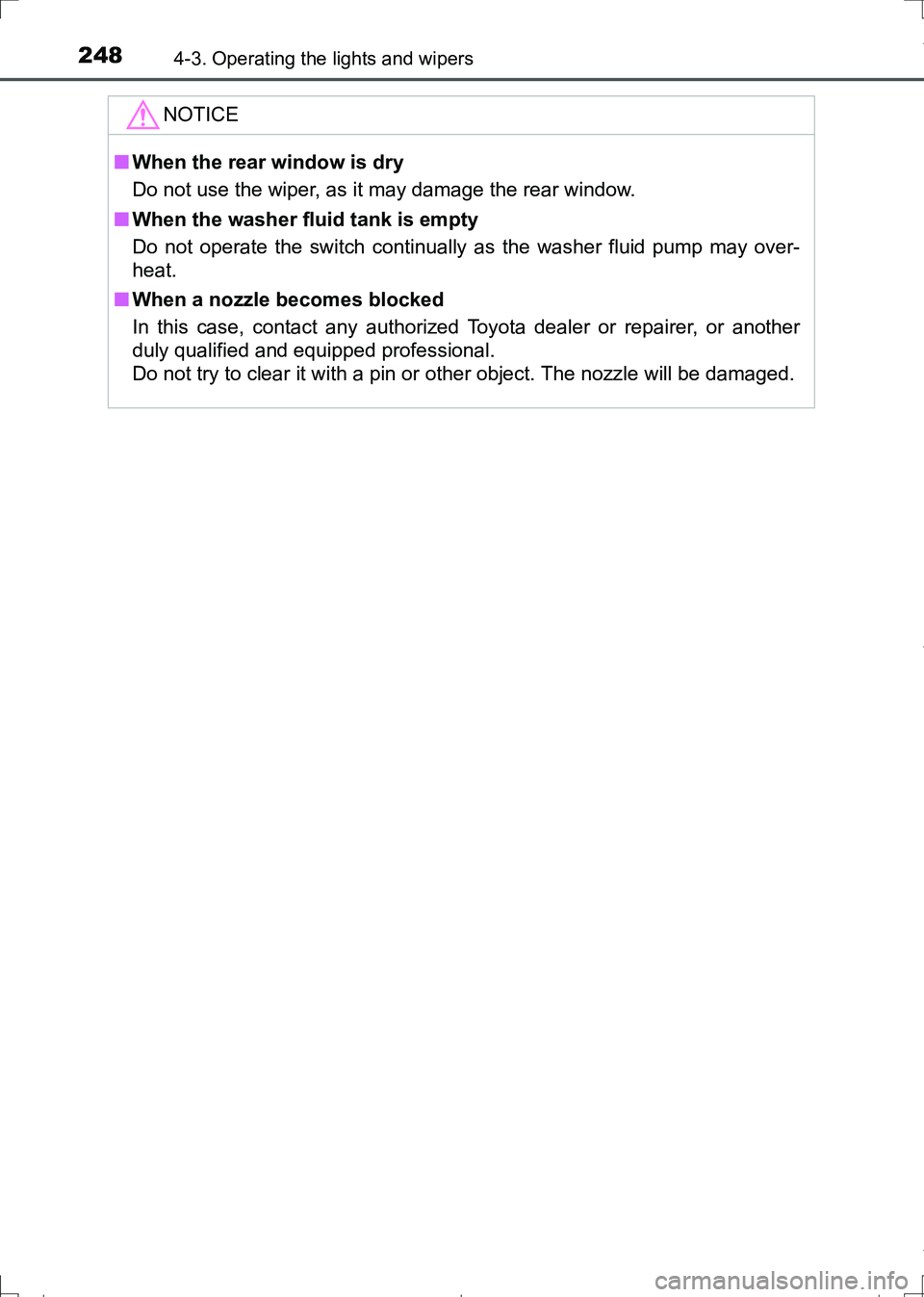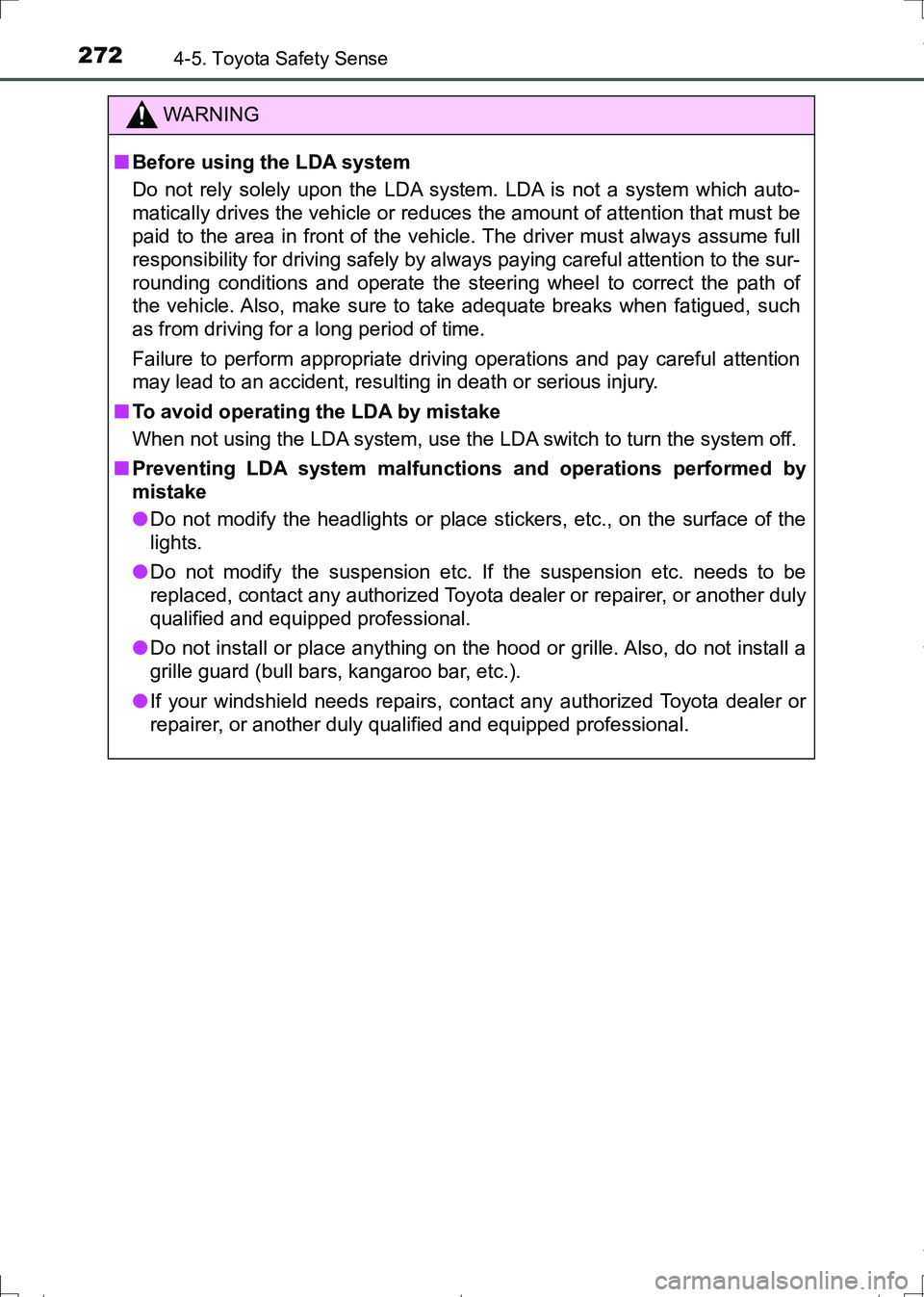2017 TOYOTA AURIS HYBRID lights
[x] Cancel search: lightsPage 247 of 664

2474-3. Operating the lights and wipers
AURIS Touring Sports_EE (12L13E)
4
Driving
The wiper operation is selected by moving the lever as follows:
Intermittent window
wiper operation
Normal window wiper
operation
Washer/wiper dual operation
The wiper will automatically oper-
ate a couple of times after the
washer squirts.
■The rear window wiper and washer can be operated when
Vehicles without a smart entry & start system
The engine switch is in the “ON” position.
Vehicles with a smart entry & start system
The engine switch is in IGNITION ON mode.
■If no windshield washer fluid sprays
Check that the washer nozzle is not blocked if there is washer fluid in the
windshield washer fluid reservoir.
Rear window wiper and washer
Operating the wiper lever
1
2
3
AURIS Touring Sports_OM_Europe_OM12L13E.book 247 ページ 2016年6月27日 月曜日 午後5時21分
Page 248 of 664

2484-3. Operating the lights and wipers
AURIS Touring Sports_EE (12L13E)
NOTICE
■When the rear window is dry
Do not use the wiper, as it may damage the rear window.
■When the washer fluid tank is empty
Do not operate the switch continually as the washer fluid pump may over-
heat.
■When a nozzle becomes blocked
In this case, contact any authorized Toyota dealer or repairer, or another
duly qualified and equipped professional.
Do not try to clear it with a pin or other object. The nozzle will be damaged.
AURIS Touring Sports_OM_Europe_OM12L13E.book 248 ページ 2016年6月27日 月曜日 午後5時21分
Page 257 of 664

2574-5. Toyota Safety Sense
AURIS Touring Sports_EE (12L13E)
4
Driving
WARNING
●If water droplets cannot be properly removed from the area of the wind-
shield in front of the front sensor by the windshield wipers, replace the
wiper insert or wiper blade.
If the wiper inserts or wiper blades need to be replaced, contact any autho-
rized Toyota dealer or repairer, or another duly qualified and equipped pro-
fessional.
●Do not attach window tinting to the windshield.
●Replace the windshield if it is damaged or cracked.
If the windshield needs to be replaced, contact any authorized Toyota
dealer or repairer, or another duly qualified and equipped professional.
●Do not install an antenna in front of the sensor.
●Do not get the front sensor wet.
●Do not allow bright lights to shine into the front sensor.
●Do not dirty or damage the front sensor.
When cleaning the inside of the windshield, do not allow glass cleaner to
contact the lens. Also, do not touch the lens.
If the lens is dirty or damaged, contact any authorized Toyota dealer or
repairer, or another duly qualified and equipped professional.
●Do not subject the front sensor to a strong impact.
●Do not change the installation position or direction of the front sensor or
remove it.
●Do not disassemble the front sensor.
●Do not install an electronic device or device that emits strong electric
waves near the front sensor.
●Do not modify any components of the vehicle around the front sensor
(inside rear view mirror, sun visors, etc.) or ceiling.
●Do not attach any accessories that may obstruct the front sensor to the
hood, front grille or front bumper. Contact any authorized Toyota dealer or
repairer, or another duly qualified and equipped professional for details.
●If a surfboard or other long object is to be mounted on the roof, make sure
that it will not obstruct the front sensor.
●Do not modify the headlights or other lights.
●Do not attach anything to or place anything on the dashboard.
■Installation area of front sensor on windshield
When the windshield is fogging up easily, the glass around the front sensor
may be hot due to the heater running. If the glass is touched, it may result in
burns.
AURIS Touring Sports_OM_Europe_OM12L13E.book 257 ページ 2016年6月27日 月曜日 午後5時21分
Page 268 of 664

2684-5. Toyota Safety Sense
AURIS Touring Sports_EE (12L13E)• When the vehicle is hit by water, snow, dust, etc. from a vehicle ahead
• When driving through steam or smoke that may obscure vehicles ahead
• When driving in a place where the surrounding brightness changes sud-
denly, such as at the entrance or exit of a tunnel
• While driving on a curve and for a certain amount of time after driving on
a curve • When a vehicle ahead is not directly
in front of your vehicle
• When driving in inclement weather
such as heavy rain, fog, snow or a
sand storm
• When a very bright light, such as the
sun or the headlights of oncoming
traffic, shines directly into the front
sensor
• When the surrounding area is dim,
such as at dawn or dusk, or while at
night or in a tunnel
AURIS Touring Sports_OM_Europe_OM12L13E.book 268 ページ 2016年6月27日 月曜日 午後5時21分
Page 272 of 664

2724-5. Toyota Safety Sense
AURIS Touring Sports_EE (12L13E)
WARNING
■Before using the LDA system
Do not rely solely upon the LDA system. LDA is not a system which auto-
matically drives the vehicle or reduces the amount of attention that must be
paid to the area in front of the vehicle. The driver must always assume full
responsibility for driving safely by always paying careful attention to the sur-
rounding conditions and operate the steering wheel to correct the path of
the vehicle. Also, make sure to take adequate breaks when fatigued, such
as from driving for a long period of time.
Failure to perform appropriate driving operations and pay careful attention
may lead to an accident, resulting in death or serious injury.
■To avoid operating the LDA by mistake
When not using the LDA system, use the LDA switch to turn the system off.
■Preventing LDA system malfunctions and operations performed by
mistake
●Do not modify the headlights or place stickers, etc., on the surface of the
lights.
●Do not modify the suspension etc. If the suspension etc. needs to be
replaced, contact any authorized Toyota dealer or repairer, or another duly
qualified and equipped professional.
●Do not install or place anything on the hood or grille. Also, do not install a
grille guard (bull bars, kangaroo bar, etc.).
●If your windshield needs repairs, contact any authorized Toyota dealer or
repairer, or another duly qualified and equipped professional.
AURIS Touring Sports_OM_Europe_OM12L13E.book 272 ページ 2016年6月27日 月曜日 午後5時21分
Page 275 of 664

2754-5. Toyota Safety Sense
AURIS Touring Sports_EE (12L13E)
4
Driving
■Conditions in which functions may not operate properly
In the following situations, the front sensor may not detect white (yellow) lines
and various functions may not operate normally.
●There are shadows on the road that run parallel with, or cover, the white
(yellow) lines.
●The vehicle is driven in an area without white (yellow) lines, such as in front
of a tollgate or checkpoint, or at an intersection, etc.
●The white (yellow) lines are cracked, or cat's eyes (reflective markers) or
stones are present.
●The white (yellow) lines cannot be seen or are difficult to see due to sand,
etc.
●The vehicle is driven on a road surface that is wet due to rain, puddles, etc.
●The traffic lines are yellow (which may be more difficult to recognize than
lines that are white).
●The white (yellow) lines cross over a curb, etc.
●The vehicle is driven on a bright surface, such as concrete.
●The vehicle is driven on a surface that is bright due to reflected light, etc.
●The vehicle is driven in an area where the brightness changes suddenly,
such as at the entrances and exits of tunnels, etc.
●Light from the headlights of an oncoming vehicle, the sun, etc., enters the
camera.
●The vehicle is driven where the road diverges, merges, etc.
●The vehicle is driven on a slope.
●The vehicle is driven on a road which tilts left or right, or a winding road.
●The vehicle is driven on an unpaved or rough road.
●The vehicle is driven around a sharp curve.
●The traffic lane is excessively narrow or wide.
●The vehicle is extremely tilted due to carrying heavy luggage or having
improper tire pressure.
●The distance to the preceding vehicle is extremely short.
●The vehicle is moving up and down a large amount due to road conditions
during driving (poor roads or road seams).
●The headlight lenses are dirty and emit a faint amount of light at night, or the
beam axis has deviated.
●The vehicle has just changed lanes or crossed an intersection.
■Warning messages for the LDA system
Warning messages are used to indicate a system malfunction or to inform the
driver of the need for caution while driving.
■Customization
P. 1 1 0
AURIS Touring Sports_OM_Europe_OM12L13E.book 275 ページ 2016年6月27日 月曜日 午後5時21分
Page 276 of 664

2764-5. Toyota Safety Sense
AURIS Touring Sports_EE (12L13E)
Push the lever away from you with
the headlight switch in
position.
The Automatic High Beam indica-
tor will come on when the head-
lights are turned on automatically
to indicate that the system is
active.
: If equipped
Automatic High Beam
The Automatic High Beam uses an in-vehicle front sensor to
assess the brightness of streetlights, the lights of vehicles
ahead etc., and automatically turns the high beam on or off as
necessary.
WARNING
■Limitations of the Automatic High Beam
Do not rely on the Automatic High Beam. Always drive safely, taking care to
observe your surroundings and turning the high beam on or off manually if
necessary.
■To prevent incorrect operation of the Automatic High Beam system
Do not overload the vehicle.
Activating the Automatic High Beam system
AURIS Touring Sports_OM_Europe_OM12L13E.book 276 ページ 2016年6月27日 月曜日 午後5時21分
Page 278 of 664

2784-5. Toyota Safety Sense
AURIS Touring Sports_EE (12L13E)
■High beam automatic turning on or off conditions
●When all of the following conditions are fulfilled, the high beam will be auto-
matically turned on (after approximately 1 second):
• Vehicle speed is approximately 40 km/h (25 mph) or more.
• The area ahead of the vehicle is dark.
• There are no vehicles ahead with headlights or tail lights turned on.
• There are few streetlights on the road ahead.
●If any of the following conditions is met, the high beams will turn off automat-
ically:
• Vehicle speed is below approximately 30 km/h (19 mph).
• The area ahead of the vehicle is not dark.
• Vehicles ahead have their headlights or tail lights turned on.
• There are many streetlights on the road ahead.
■Front sensor detection information
●The high beam may not be automatically turned off in the following situa-
tions:
• When vehicles ahead suddenly appear from a curve
• When the vehicle is cut in front of by another vehicle
• When vehicles ahead are hidden from sight due to repeated curves, road
dividers or roadside trees
• When vehicles ahead appear from the faraway lane on wide road
• When vehicles ahead have no lights
●The high beam may be turned off if a vehicle ahead that is using fog lights
without using the headlights is detected.
●House lights, street lights, traffic signals, and illuminated billboards or signs
may cause the high beam to switch to the low beams, or the low beams to
remain on.
●The following factors may affect the amount of time taken to turn the high
beam on or off:
• The brightness of headlights, fog lights, and tail lights of vehicles ahead
• The movement and direction of vehicles ahead
• When a vehicle ahead only has operational lights on one side
• When a vehicle ahead is a two-wheeled vehicle
• The condition of the road (gradient, curve, condition of the road surface,
etc.)
• The number of passengers and amount of luggage
●The high beam may be turned on or off when the driver does not expect it.
●Bicycles or similar objects may not be detected.
AURIS Touring Sports_OM_Europe_OM12L13E.book 278 ページ 2016年6月27日 月曜日 午後5時21分